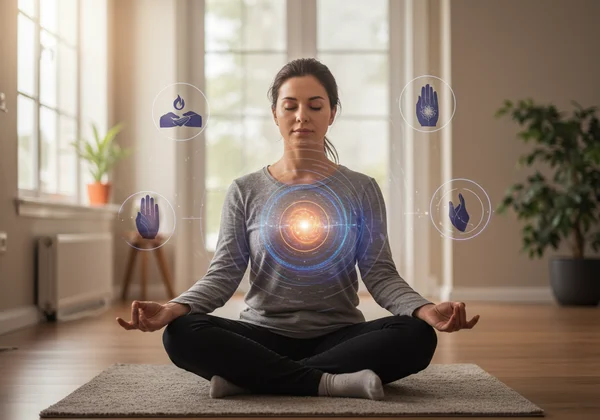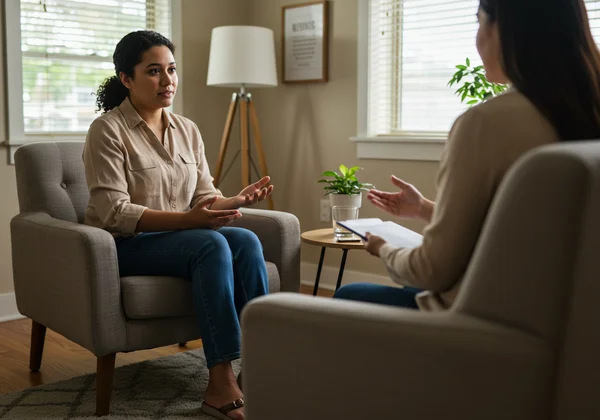Living with Agoraphobia: Daily Life, Coping Strategies, and Your Agoraphobia Test Guide
Living with agoraphobia can feel like navigating a world full of invisible walls. The anxiety, the avoidance, the persistent fear—it can shrink your life until your safe space feels more like a cage. If you're reading this, you might be feeling isolated, misunderstood, or simply exhausted from the daily effort it takes to manage these feelings. You are not alone. Understanding this condition is the first crucial step toward reclaiming your life, and this guide is here to walk that path with you. We'll explore the realities of living with agoraphobia, from daily challenges to practical coping methods. You may be wondering, how do I tell if I'm developing agoraphobia? Gaining clarity on your experiences is a powerful move, and a great place to start is with a confidential self-assessment tool.
Agoraphobia's Footprint: Understanding Your Daily Life
Agoraphobia is more than just a fear of open spaces; it's a complex anxiety disorder that fundamentally alters how you interact with the world. It’s the fear of being in situations where escape might be difficult or help might not be available if you have a panic attack. This fear can permeate every aspect of your day, dictating what you can and cannot do.

The Invisible Walls: How Fear Shapes Your Routine
For many, the day begins not with an alarm clock, but with a mental checklist of potential triggers. A simple decision like what to eat for breakfast can be influenced by whether it requires ingredients from a store you're afraid to visit. Fear shapes your routine in subtle and profound ways. You might find yourself meticulously planning your days to avoid specific places, times, or situations—the crowded bus, the wide-open park, the long queue at the bank. This constant state of high alert is mentally draining and can leave you feeling perpetually on edge, even within the safety of your own home.
Managing Basic Needs: Errands, Chores, and Appointments
What most people consider mundane tasks can become monumental challenges. Grocery shopping, picking up a prescription, or attending a doctor's appointment can trigger intense anxiety. This often leads to a heavy reliance on others or on services like grocery delivery. While these are fantastic tools, over-reliance can reinforce the cycle of avoidance. The internal conflict between needing to get things done and the overwhelming fear of doing them is a constant battle. This is where understanding your specific triggers becomes vital, something an online agoraphobia test can help you begin to identify.
Navigating Social Connections from Within Your Comfort Zone
Humans are social creatures, but agoraphobia can make maintaining relationships incredibly difficult. Turning down invitations from friends and family isn't a reflection of your love for them, but a measure of self-preservation against crippling anxiety. This can lead to feelings of guilt, loneliness, and misunderstanding from loved ones who may not grasp the severity of your fear. However, many people find creative ways to nurture social bonds, using technology for video calls, online gaming, or joining supportive online communities. It's about adapting and finding new ways to connect that respect your boundaries.
Beyond the Threshold: Can You Be Agoraphobic & Still Leave Home?
One of the biggest misconceptions about agoraphobia is that it means you are completely housebound. While this is true for some in severe cases, it's not the reality for everyone. The question, can you be agoraphobic and still leave the house, is a common one, and the answer is a resounding yes.

The Spectrum of Agoraphobia: From Severe Avoidance to Managed Outings
Agoraphobia exists on a spectrum. One person might be unable to step onto their porch, while another can manage trips to specific "safe" places, perhaps with a trusted companion. Some may be able to commute to work but feel intense panic at the thought of going to a movie theater. Understanding that there are varying degrees of agoraphobia is validating. It’s not an all-or-nothing condition. Your experience is unique, and recognizing where you fall on this spectrum is a key part of your journey.
Celebrating Small Victories: Redefining "Leaving the House"
When you live with agoraphobia, progress isn't measured in miles, but in brave steps. "Leaving the house" might not mean a trip across town; it could mean walking to the mailbox, sitting on the front porch for five minutes, or driving around the block. Celebrating these small victories is essential for building momentum and self-confidence. Each step, no matter how minor it seems to others, is a testament to your strength and determination.
When "Good Days" and "Bad Days" Define Your Boundaries
Living with agoraphobia often involves a constant negotiation between "good days" and "bad days." On a good day, you might feel capable of tackling a challenging errand. On a bad day, the thought of opening the front door can be paralyzing. Learning to listen to your body and mind, and giving yourself compassion on bad days, is not a sign of weakness; it's a smart coping strategy. It’s about managing your energy and setting realistic expectations for yourself without judgment.
Building Your Toolkit: Practical Agoraphobia Coping Skills
While professional therapy is the most effective treatment for agoraphobia, there are many self-help strategies you can use to manage symptoms and improve your quality of life. Building a personal toolkit of agoraphobia coping skills can empower you to face your fears with greater confidence.

Grounding Techniques and Mindfulness for Managing Panic
When panic begins to set in, your thoughts can spiral. Grounding techniques are powerful tools to pull you back to the present moment. The 5-4-3-2-1 method is a popular one: identify five things you can see, four things you can touch, three things you can hear, two things you can smell, and one thing you can taste. This sensory focus disrupts the panic cycle. Similarly, mindfulness practices, such as focusing on your breath, can help you observe anxious thoughts without getting swept away by them.
Creating Your Safe Space: Strategies for Home and Beyond
Your home is often your primary safe space, but you can also learn to create a "portable" sense of safety. This might involve carrying a comforting object, listening to a calming playlist on headphones, or having a trusted person on call. Establishing a safe zone is about control. When you feel a sense of control over your environment, anxiety often lessens. This strategy is a stepping stone to gradually expanding your comfort zone.
Communicating Your Needs: Seeking Support from Loved Ones
Your support system is one of your most valuable assets. However, friends and family can't help if they don't understand what you're going through. Learning to articulate your needs is a skill. Explain what agoraphobia feels like for you. Tell them what is helpful (e.g., "Could you walk with me to the store?") and what isn't (e.g., "Please don't tell me to 'just get over it.'"). Clear communication builds bridges of understanding and strengthens your support network.
Finding Joy & Purpose: A Full Life with Agoraphobia
Living with agoraphobia doesn't mean your life has to be devoid of joy, passion, and purpose. It's about adapting your pursuit of happiness to fit your current reality while working towards your recovery goals. A full and meaningful life is entirely possible.
Embracing Hobbies and Interests Within Your Comfort Zone
What do you love to do? Rediscovering old hobbies or finding new ones that can be enjoyed from home is a fantastic way to boost your mood and sense of self. Whether it's painting, learning a new language online, gardening, writing, or coding, engaging your mind in fulfilling activities provides a welcome distraction from anxiety and reminds you that you are more than your diagnosis.
Setting Realistic Goals and Celebrating Every Step Forward
Recovery from agoraphobia is a marathon, not a sprint. Setting achievable goals is crucial. Instead of "I will go to the mall tomorrow," a more realistic goal might be, "I will sit in my car in the driveway for ten minutes today." Breaking down larger goals into tiny, manageable steps makes them feel less daunting and sets you up for success. Remember to celebrate every single step forward.
When to Seek Professional Support on Your Journey
Self-help strategies are powerful, but they are often most effective when paired with professional guidance. If agoraphobia is significantly impacting your ability to live your life, it is a sign of strength, not weakness, to seek professional help. Therapists specializing in anxiety disorders can provide treatments like Cognitive Behavioral Therapy (CBT) and Exposure Therapy, which have been proven highly effective. If you're unsure where to begin, taking a free agoraphobia test can provide a clear summary of your symptoms to share with a healthcare provider.

The Path Forward
You've taken a significant step today by exploring the realities of living with agoraphobia. Remember, this journey is unique to you, marked by growth, resilience, and unwavering hope. By understanding its impact, acknowledging the spectrum of experiences, and arming yourself with coping strategies, you're already building the strength to navigate those invisible walls.
Empowering yourself with knowledge is the first step toward reclaiming your life. If you see your experiences reflected in these words, we encourage you to gain more clarity. Visit our site to take a free, quick, and confidential agoraphobia self-assessment. It’s a simple action that can provide the insights you need to confidently move forward on your path to recovery.
Frequently Asked Questions About Agoraphobia and Daily Life
How do I tell if I'm developing agoraphobia?
Developing agoraphobia often starts with experiencing panic attacks and then begins to involve a persistent fear of having another one in a public place. You might notice yourself actively avoiding situations like public transport, large crowds, or being far from home. If fear of these situations causes significant distress and interferes with your daily routine, it's a strong indicator. An online screening tool can help you organize these thoughts and symptoms.
What are the levels of agoraphobia?
Agoraphobia is best understood as a spectrum. On the milder end, a person might feel significant anxiety in triggering situations but can still force themselves to endure them. In moderate cases, avoidance becomes more pronounced, and a person may need a companion to leave the house. In severe cases, individuals may become completely housebound, unable to leave for any reason without experiencing extreme panic.
What not to do with agoraphobia?
It's crucial not to isolate yourself completely or to be too hard on yourself. Avoid falling into the trap of self-blame or shame. Don't rely solely on avoidance as a long-term strategy, as it can reinforce the fear cycle. Also, avoid self-medicating with alcohol or unprescribed drugs, as this can worsen anxiety in the long run.
Can you suddenly get agoraphobia?
While the avoidance behaviors can develop gradually, the onset can sometimes feel sudden. Often, agoraphobia is triggered by one or more unexpected panic attacks. After a frightening experience, a person may quickly develop a fear of that situation recurring, leading to rapid avoidance and the development of agoraphobic patterns.